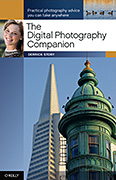
I was struck by irony as I photographed the closing of Virgin Records in San Francisco. The once megastore of music with its flashing lights and state of the art individual listening stations is now an empty shell. Just a few months ago, you could buy any CD imaginable, then choose from a variety of accessories to go with it: posters, clothing, music players. On Friday nights, it was a great place to just hang out.
Now, as they liquidate the fixtures in Virgin, across the street there's standing room only in the Apple Store. For $79 you can buy a 4 GB iPod, connect it to your computer, and fill it up with music. An entire CD library can be clipped to your shirt. The device is so light that you wouldn't know it was there, save the earbuds humming in your ears.
It's one thing to contemplate how quickly times have changed as you listen to music through tiny headphones. It's another to see it happen with your very own eyes.
Photo by Derrick Story. Captured with a Canon 5D Mark II, 24-105 mm f/4 zoom at 24mm. ISO 200, 1/250th at f/11. Image was processed in Adobe Camera Raw. Used Jobo photoGPS for geodata.
More Signs of the Times Stories
The Closing of Gottschalks Department Stores
-
Technorati Tags: Derrick Story, digital photography, Signs of the Times, The Digital Story























